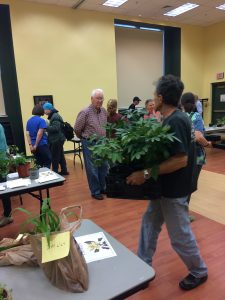The tables in the community room at the Blacksburg Public Library, tidily marked “Ornamental,” “Vegetable,” “Fruit” and “ Herbs” were loaded with gardener’s bounty at the Spring Plant and Seed Swap this weekend.

With boxes of peonies and envelopes of last summer’s watermelon seeds, gardeners gathered at Blacksburg library to swap plants and share culture, knowledge and know-how.
About 50 people hauled in pots of peonies, buckets of daylilies and coneflowers, cardboard boxes of bee balm and Echinacea and clumps of wood hyacinths already blooming purple.
Envelopes of seeds—saved from last summer’s gardens, were piled like mail on the tables, hand-marked “Cranberry Bean- 12 seeds,” “Watermelon-yellow” or “Sunflower seeds: Delicious.”
Brenda Graff, a New River Valley Master Gardener, started the swap in the fall of 2012. She and friend Su Clauson said they had been going to seed swaps in Christiansburg and had seen a lot of Blacksburg people.
“We’ve got gardens in both places,” said Graff, in a blue Duke Gardens T-shirt. “We should have one in Blacksburg.”
With a “bring-a-plant, take-a-plant” sensibility, to anthropologists, the event is a “balanced reciprocal gift exchange,” in garden vernacular it’s a “swap.”
Plant swaps and seed exchanges are an ancient and universal practice. By sharing sweet potato slips and heirloom tomatoes with names like “Honeydrop Cherry” and “Mr. Stripey” with neighbors, friends, and strangers, swaps grow fellowship while sharing culture, technical know-how and ecological knowledge.
Moving plants to new gardens, growing and talking about them spreads genetic diversity, and protects and nurtures old varieties that might be commercially unworthy, but interesting to a garden or a palate.
Plant and seed swaps are a good idea for practically any circumstance.
“It helps people when they’ve just moved in without enough plants, and for people who have too many plants. Or they’ve got plants that aren’t doing well in their garden’s conditions. And it’s free,” Graff said.
Peg Fisher, a Master Gardener and Blacksburg resident, who has attended the swap several times, has brought fists of green and white onion slips.
“I have more than I can count,” she said. “It’s a way to get different things I’m not growing myself.”
That afternoon, the swap is brisk and Graff and Clauson hurry to tape signs to tables, help carry the armloads of bee balm and cardboard boxes of lily of the valley gently leaking soil across the room.
Graff, a Cornell graduate and gardener to her roots, had started seed swaps in Northern Virginia where she was a natural resources librarian for the federal government. Retired now, she’s at SEEDS the Blacksburg nature center.
In addition to organizing the event, she’s hauled in daylilies from SEEDs as they revamp their garden with pollinator-powerhouses, cardinal flower and blue lobelia.
People bring in their plants and seeds by 2 p.m. and the swap begins thirty minutes later.
In small orange Dixie cups, Corry Hamilton a VT engineering student was bringing in little marigolds and coneflowers in peat pots she’d started from seed.
“I have rabbits,” she said. “They love marigolds, so I grow them. Saves a lot on grocery bills…. and therapy. Gardening is good therapy,” she said.
Now full of plants, the room is full of knowledge too and people are helping identifying obscure wildflowers.
“It’s a Siberian…Siberian something….maybe a Siberian bugloss. Yes, I think that’s right. Little blue flowers. It’s good for ground cover,” a gardener said.
By quarter to three it’s all over and people are hauling away their acquisitions.
Teresa Johansson and husband Emilio Santini had brought 15 tomato plants and 20 rhubarbs. (“It was a mistake,” he said.) Among the tomatoes they brought were, “Principe Borghese, the best drying tomato ever,” she said. She hauled home irises.
Having brought Asian beans and tomato plants, Susan Chen, a VT graduate student in Human Nutrition, Food and Exercise, whose research focuses on food waste, went home with purple fingerling potatoes and purple coneflower seeds.
Blacksburg town councilman Michael Sutphin, brought Brandywine and black cherry tomatoes swapping them for Japer Cherry tomatoes and Red Kuri squash seeds.
“I got Columbine and yellow Japanese iris and raspberries and an envelope of cranberry beans,” VT biology instructor Meg Emori said.
It’s just after 3 p.m. and Graff and Clauson are wiping and folding the tables and sweeping up the last of the leaves and potting soil.
People with armloads of yellow iris and bags of sweet potato slips stop to talk in the parking lot heading home to garden, raise new plants and seeds, and return in the fall.




